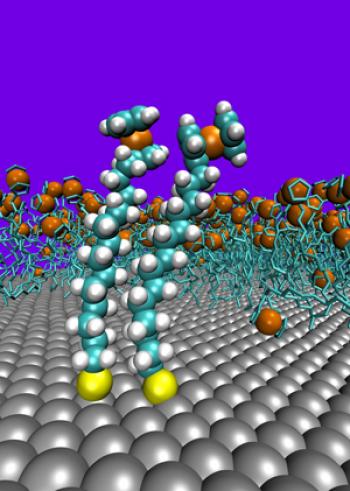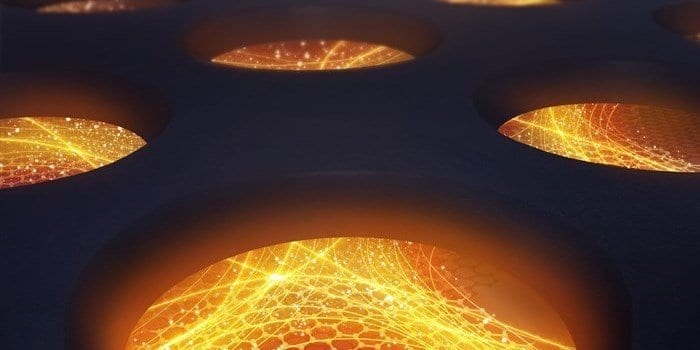
Fifty thousand of the rectifier molecules strung end to end would fit across the diameter of a human hair
A team of scientists from Tyndall National Institute at University College Cork and the National University of Singapore have designed and fabricated ultra-small devices for energy-efficient electronics. By finding out how molecules behave in these devices, a ten-fold increase in switching efficiency was obtained by changing just one carbon atom. These devices could provide new ways to combat overheating in mobile phones and laptops, and could also aid in electrical stimulation of tissue repair for wound healing. The breakthrough creation of molecular devices with highly controllable electrical properties will appear in the February issue of Nature Nanotechnology (Advance Online Publication doi:10.1038/nnano.2012.238). Dr. Damien Thompson at the Tyndall National Institute, UCC and a team of researchers at the National University of Singapore led by Prof. Chris Nijhuis designed and created the devices, which are based on molecules acting as electrical valves, or diode rectifiers.
Dr. Thompson explains “These molecules are very useful because they allow current to flow through them when switched ON and block current flow when switched OFF. The results of the study show that simply adding one extra carbon is sufficient to improve the device performance by more than a factor of ten. We are following up lots of new ideas based on these results, and we hope ultimately to create a range of new components for electronic devices.” Dr. Thompson’s atom-level computer simulations showed how molecules with an odd number of carbon atoms stand straighter than molecules with an even number of carbon atoms. This allows them to pack together more closely. Tightly-packed assemblies of these molecules were formed on metal electrode surfaces by the Nijhuis group in Singapore and were found to be remarkably free of defects. These high quality devices can suppress leakage currents and so operate efficiently and reliably. The device can be cleanly switched on and off purely on the basis of the charge and shape of the molecules, just like in the biological nanomachines that regulate photosynthesis, cell division and tissue growth.
Tyndall Electronic Theory Group leader Prof. Jim Greer explains: “Modern electronic devices such as telephones and tablets in manufacture today rely on tiny switches approaching molecular sizes. This provides new challenges for electronics but opens up exciting opportunities for blending molecular properties to be used to advantage. Dr. Thompson’s work is an exciting new avenue to exploit molecular design to achieve new ways to perform information processing.” A key enabling feature for nanoscale electronics will be the ability to use molecules as rectifiers and switches. By demonstrating the rational design of molecules that rectify current with a large and highly-reproducible ON/OFF ratio, the study provides a key advance towards the creation of technologically viable ultra-small device components. Fifty thousand of the rectifier molecules strung end to end would fit across the diameter of a human hair. Advances in computing, synthesis and characterisation means scientists can now understand and control material at the scale of atoms and molecules.
The Latest Bing News on:
Nanoscale electronics
- ‘They want this, all of it’: The global arms race you can’t see – and China wants the edgeon May 12, 2024 at 4:20 pm
Microchips are key to powering the world. What will it take to win in this vital (and secretive) multi-billion-dollar world?
- Researchers demonstrate enhanced radiative heat transfer for nanodeviceson May 9, 2024 at 8:01 am
Researchers from Japan have been working hard to keep their cool—or at least—keep their nanodevices from overheating. By adding a tiny coating of silicon dioxide to micro-sized silicon structures, ...
- Research team discovers new property of lighton May 7, 2024 at 5:59 am
A research team headed by chemists at the University of California, Irvine has discovered a previously unknown way in which light interacts with matter, a finding that could lead to improved solar ...
- Georgia Tech group create world’s first graphene-based semiconductoron April 26, 2024 at 10:13 am
A group of researchers at the Georgia Institute of Technology (Georgia Tech) have created the world’s first functional semiconductor made from graphene, a development that could lead to advanced ...
- Atom-by-atom: Imaging structural transformations in 2D materialson April 16, 2024 at 5:01 pm
Silicon-based electronics are approaching their physical ... in turn, affects both its nanoscale and microscopic behavior." The structure and properties of 2D multilayers are often highly ...
- Quantum electronics: Charge travels like light in bilayer grapheneon April 15, 2024 at 5:00 pm
energy-efficient transistors -- like the light switch in your house but at a nanoscale. An international research team led by the University of Göttingen has demonstrated experimentally that ...
- Nanoscale Movies Shed Light on One Barrier to a Clean Energy Futureon April 9, 2024 at 5:00 pm
Using nanoscale imaging techniques, Duke researchers are trying to understand why these catalysts break down and lose activity over time. Credit: Avery Vigil, Duke chemistry Part of the trouble is ...
- Molecular Electronics: Building Circuits at the Nanoscaleon April 3, 2024 at 2:36 pm
Molecular electronics is a branch of nanotechnology that focuses on using individual molecules or nanoscale molecular structures as electronic components to create miniaturized circuits and devices.
- Will fluidic electronics take off?on February 17, 2024 at 7:16 pm
A nanoscale fluid-based analogue of this device ... are in a position to take on the same applications as semiconductor electronics? Certainly no other technology in the last forty years has ...
- Electronics storeson December 30, 2023 at 3:23 pm
Electronics store Ratings Find the top deals on gadgets and devices at the best electronics stores. From computers to cameras and even home appliances, electronics stores carry many must-haves.
The Latest Google Headlines on:
Nanoscale electronics
[google_news title=”” keyword=”nanoscale electronics” num_posts=”10″ blurb_length=”0″ show_thumb=”left”] [/vc_column_text]The Latest Bing News on:
Molecular electronics
- Strictly no dancing: Researchers discover 'new molecular design rules'on May 8, 2024 at 8:51 am
Since the discovery of quantum mechanics more than a hundred years ago, it has been known that electrons in molecules can be coupled to the motion of the atoms that make up the molecules. Often ...
- Molecular Assemblies Launches Partner Program for Onsite Synthesis of Long, Pure, Accurate DNAon May 7, 2024 at 5:00 am
Molecular Assemblies, Inc., ("MAI" or the "Company") a pioneer and leader in the field of enzymatic DNA synthesis, today announced the launch of its Partnering Program to license Molecular Assemblies' ...
- Attosecond core-level spectroscopy reveals real-time molecular dynamicson May 6, 2024 at 8:44 am
Chemical reactions are complex mechanisms. Many different dynamic processes are involved, affecting both the electrons and the nucleus of the present atoms. Very often, the strongly coupled electron ...
- New memory transistor integrates photocrosslinker into molecular switches to adjust its threshold voltageon May 2, 2024 at 9:22 am
A research team has developed a memory transistor capable of adjusting its threshold voltage. This innovation combines two molecules that form a stable bond with a polymeric semiconductor, situated at ...
- Molecular Biology Newson April 30, 2024 at 5:00 pm
May 9, 2024 — In a study of a species of African butterfly, researchers have discovered a previously undescribed molecular mechanism of how the sex of an embryo is initially ... Fruit Fly Model ...
- Molecular Psychiatryon April 28, 2024 at 5:00 pm
Molecular Psychiatry is a scientific journal published by Nature Publishing Group. It publishes papers in biological psychiatry and, e.g., about psychiatric genetics. With an impact factor of 15. ...
- Molecular electronics: what will future gadgets be like?on April 26, 2024 at 8:58 am
In the broader field of electronics, it could bring us closer to the creation of so-called molecular electronics. It will potentially be possible to use light attosecond pulses to turn electrons into ...
- Research combines DNA origami and photolithography to move one step closer to molecular computerson April 24, 2024 at 9:08 am
There is a limit to the miniaturization of current silicon-based computer chips. Molecular electronics, using single-molecule-sized switches and memories, could provide a revolution in the size ...
- Evolving From Discrete Molecular Data Integrations to Actionable Molecular Insights Within the Electronic Health Recordon April 10, 2024 at 5:00 pm
EHR, electronic health record. Molecular technology companies must work collaboratively with EHR systems, guideline generating organizations, clinicians, regulatory bodies, and patient advocates to ...
- Molecular Electronics: Building Circuits at the Nanoscaleon April 3, 2024 at 2:36 pm
Molecular electronics is a branch of nanotechnology that focuses on using individual molecules or nanoscale molecular structures as electronic components to create miniaturized circuits and devices.
The Latest Google Headlines on:
Molecular electronics
[google_news title=”” keyword=”molecular electronics” num_posts=”10″ blurb_length=”0″ show_thumb=”left”]








